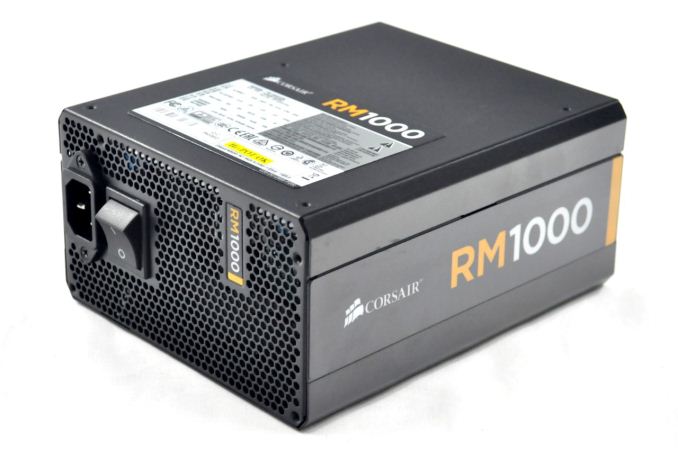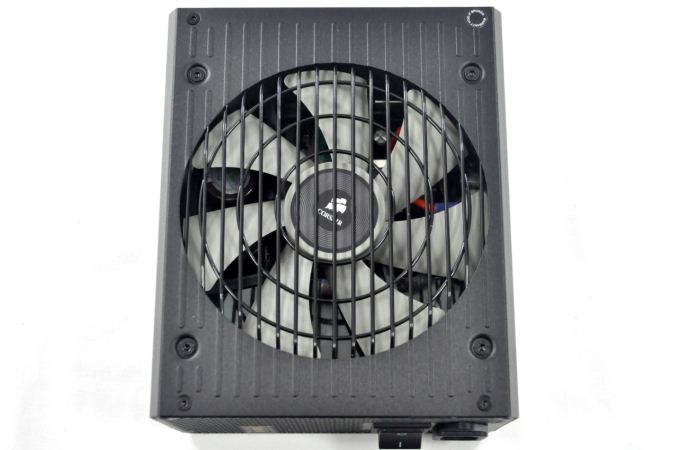Corsair RM1000 Power Supply Review
by E. Fylladitakis on April 24, 2014 6:00 AM EST- Posted in
- Cases/Cooling/PSUs
- Corsair
- PSUs
- RM Series
Conclusion
Most of Corsair's products are focused on specific target groups and the RM PSU series is targeted towards advanced users who appreciate silence above all else. The RM1000 that we reviewed today is the most powerful unit of the series, capable of feeding very high performance gaming systems. It's actually rather strange that the series would expand up to a 1000W unit; it is not impossible to build a system that would require such a massive level of power while remaining quiet, but it would be bulky and very costly. Nevertheless, if you are trying to build a very powerful and low-noise system, the RM1000 is there to lend a hand. Moreover, even though the RM1000 is focused on low-noise operation, it does not mean that Corsair neglected its performance or appearance.
Visually, the subtle modifications, such as the chamfered edges and the rimmed bottom, make the fully modular RM1000 aesthetically pleasing without standing out too much. The all-black, sleeveless cables are another attraction of the unit, as I feel they are visually superior to sleeved color-coded cables; however, because of their ribbon-like design with the wires bonded together, the cables of the RM1000 are a bit stiffer to turn and route than typical cables.
The electrical performance of the RM1000 is very good and we expected nothing less from a CWT platform, which usually are very well designed and made. The RM1000 is highly efficient and remains so even when the ambient temperature increases significantly, which is infrequent even for very advanced designs. It also provides good quality power, with low voltage ripple even under heavy stress.
Where the RM1000 could use some improvement is on thermal performance, as it seems unwise to heavily tune a 1000W unit with such small heatsinks towards low-noise operation. Despite that, the RM1000 kept performing very well during our testing, even with the ambient temperature much higher than its 40 °C rating, but the temperature of the unit increased to uncomfortable levels and the cooling system could not do anything to react because the fan's speed was already maxed out.
When it comes to quality, the Corsair RM1000 scores very well, yet there is room for improvement. The unit is very well made, with an excellent soldering and assembly job. Most primary components come from very reputable manufacturers, such as Nippon Chemi-Con and TAICON. However, some components come from manufacturers with a mediocre reputation, such as the CapXon capacitors on the secondary side of the transformer. Corsair must know what they are doing though, as they are covering the RM1000 with a five-year warranty.
The MSRP of the RM1000 is $199.90 but we found it online for $169.99 after rebate. It's not the cheapest 1000W unit with an 80 Plus Gold certification, but considering the quality and performance of the PSU, the price is justifiable. If you are the kind of user that wants a really powerful PSU tuned for low-noise operation, the RM1000 should find its way into the top few spots of your shortlist.












55 Comments
View All Comments
ssj3gohan - Monday, April 28, 2014 - link
Can I give some constructive criticism?The review is missing some parts that would be very useful:
- The teardown is extremely short and basically useless. All the information we get from it is that it's made by CWT. There is a lot more to see that is relevant, like the topology (it's obviously LLC resonant, otherwise the heatsinks for the active devices could never be that small even for a lower powered unit. They dissipate so little because they are switched at zero voltage and current all the time (ZVCS) instead of only half of the time (pseudoresonant) or never (traditional push-pull). Switching losses are the biggest issue in high current PSUs. Another important thing to note is the make of the controller chip(s), as this usually gives a good idea of the modern-ness of the design (LLC resonant has been around for 20 years, but only recently have they really started to do propagation time compensation and such awesomeness). It's also important to note that for instance on this unit, the non-important cap (input filter cap) is from a good brand and the caps that actually matter (high ripple current, high stress in general) are B or C grade. CapXon is not something I would trust handling a couple tens of amps of ripple current for 5 years. Lots of reviewers get fooled by the big shiny cap on the input having the good markings, but this misses the point of cap quality inspection. There's more that should be in the teardown, but for that I'd just recommend aping Jonnyguru, X-bit labs or such people.
- On the hot *and* cold tests (as well as crossload), at least include a table of the actually used loads and results in numbers, as well as your total (un)calibrated error - depending on whether all your instruments are calibrated or not.
- Don't fucking interpolate to get nice graphs! This is a deathly sin in data processing. It causes all kinds of crazy things, like implying that the slope of the efficiency graphs is a certain value at the edges (while it probably is something completely else) and causing the weird ripples in the efficiency curve you see. I'd bet money that that ripply stuff is just measurement error. In fact, the entire graphs are a big departure from both the 80 Plus test report and other review sites, so even if this is not actually an error on your part, we need to be able to properly compare this (with table values) to be sure. Even just the sentence 'this PSU was tested on 230VAC input while most other sites test at 115VAC input; this may inflate efficiency numbers' would greatly improve the review.
- This leads to the next point: interpret the data for us, give us a well-researched explanation for weirdness. Why do the SPL numbers look the way they look? Did you have a tachometer? Did the sound have a broad spectrum or was it whiny?
- Also: another case of interpolation causing weird graphs is the heatsink temperature graph. Cut that graph in the middle, and annotate it on the left with 'fan off' and on the right with 'fan on'. Don't try to connect the two separate domains, it is meaningless and just causes weird bumps in the graph that are not there!
- In the conclusion, don't just give a conclusion on this unit in a vacuum. You're a review site! You are supposed to know the market, know the competition. Tell us how the unit performs compared to the competition and how well it is priced. THEN give us a recommendation. Take into account the industry standing of the brand and previous PSUs. As it stands, the conclusion is not satisfactory.
I'm not trying to be harsh, but Anandtech has a good reputation and there are too few good PSU reviewers around on the internet. You're one of only 3 semi-fulltime PSU reviewers with a master's and/or PhD in the right area, so I have high hopes for the future. I already had high hopes when you were introduced for the first time, but the reviews so far have been passable instead of great. This needs to be fixed.
Michal Daniel - Wednesday, April 30, 2014 - link
Makes for a splendid hackintosh. Typing this on it.http://www.proofsheet.com/macbeast/all.html
amazingrugs - Friday, May 9, 2014 - link
I've been out of the building game for quite a while. I think the last system I built had a Radeon 9500, when AGP was all the rage! What kind of system does it take to push a PSU like this?alostpacket - Thursday, May 15, 2014 - link
You guys should never post after-rebate prices, you are doing their marketing for them.burningisis - Monday, November 16, 2015 - link
I think another use for a high wattage PSU like this other than mining or those using autocad... future proofing a machine. I know I've replaced enough PSUs on my machines as I upgrade GPUs or upgrade the number of drives I use or if I decide to push overclocking. I know some users are going smaller but there are users still out there demanding larger PSUs, running 3+ GPUs, running multiple processors on an enthusiast system. It may be a small subset of users, but there is a demand out there for these, and this looks like a very nice PSU to future proof a build as well